Samaaro + Your CRM: Zero Integration Fee for Annual Sign-Ups Until 30 June, 2025
- 00Days
- 00Hrs
- 00Min
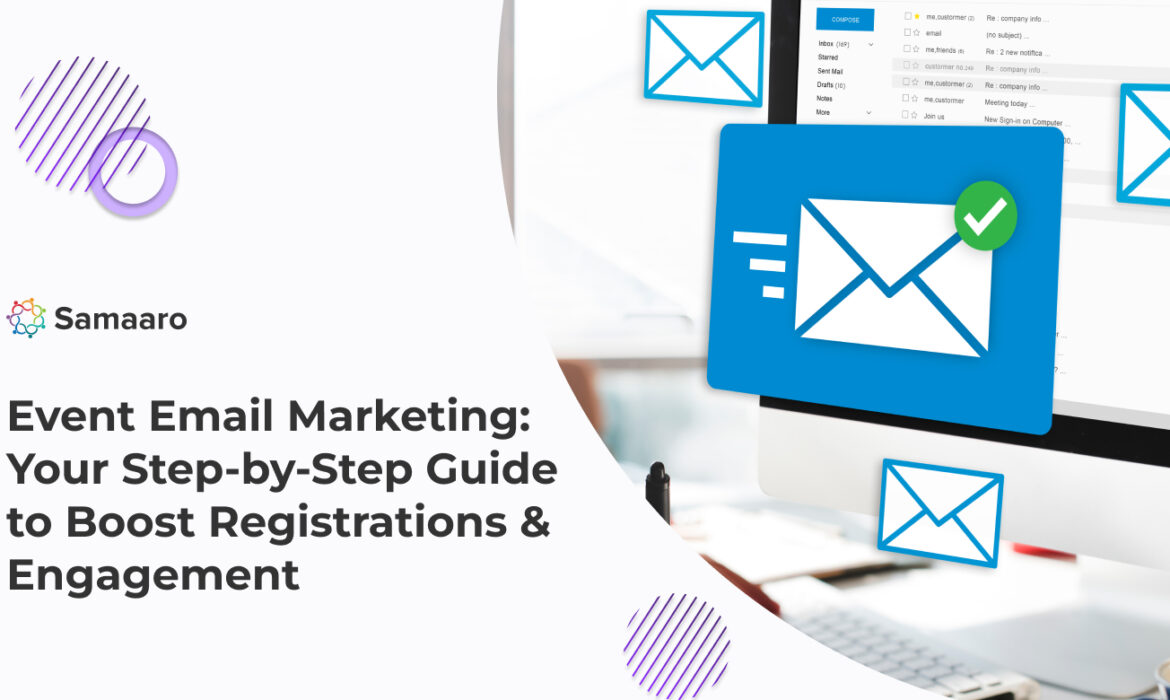
Picture this: you spend months planning the perfect event – amazing speakers, great content, a thoughtful agenda – only for attendance to flop. A scenario event organizer doesn’t want to come to pass, and most of the time, the missing piece to the puzzle is strategic communications about the event.
Event email marketing is the vital link between the promise of your event and your audience participation. It’s much more than just sending out a couple of reminder emails; it’s a focused, strategic process designed to drive registration, adopt a build-up of anticipation, and keep attendees engaged, before during and after the event.
Use this step-by-step guide as your roadmap to master event email marketing. From what exactly event email marketing is, what it means, and why is it important, to the basics of putting together effective event email campaigns and how to enhance those campaigns through automation and personalization; we have provided you with practical information that prepares you to successful at your event.
By embracing these proven strategies, you will learn how to drive registration to your event, create attendee engagement through strategic email campaigns, and help achieve your overall event goals. Regardless of if you are just starting out with your first event or looking to elevate your marketing edge, this guide will assist in giving you the elements to communicate with clarity and confidence at every stage.
Event email marketing doesn’t refer to simply sending out emails about your event, it is a clear and focused strategic approach to using email as a primary channel for communicating with your audience through the lifecycle of an event. Event email marketing creates connections, drives interest and actions from your invitation through to the thank-you email.
Event email campaigns are different from regular email marketing campaigns because they are time sensitive resulting from an event-based goal. Event email marketing included all email communication with your audience. Which may be some or all promotional, informational or engagement type messages and there is a progression in messaging, using sophistication in the order and number of emails, with a gentle nudge to push attendees through the funnel of registration and attending the event.
Seven characteristics of an event email marketing strategy, identified as key elements of success:
Why is event email marketing your event’s best resource?
When it comes to delivering a successful event email marketing is low cost, measurable, direct to audience. Let us explain the key points email marketing circles for your event strategy:
Low Cost & Measurable: You need to measure key email metrics, such at read rates, click rates, and conversion-based reporting, for on-going email campaigns and ensure the best return.
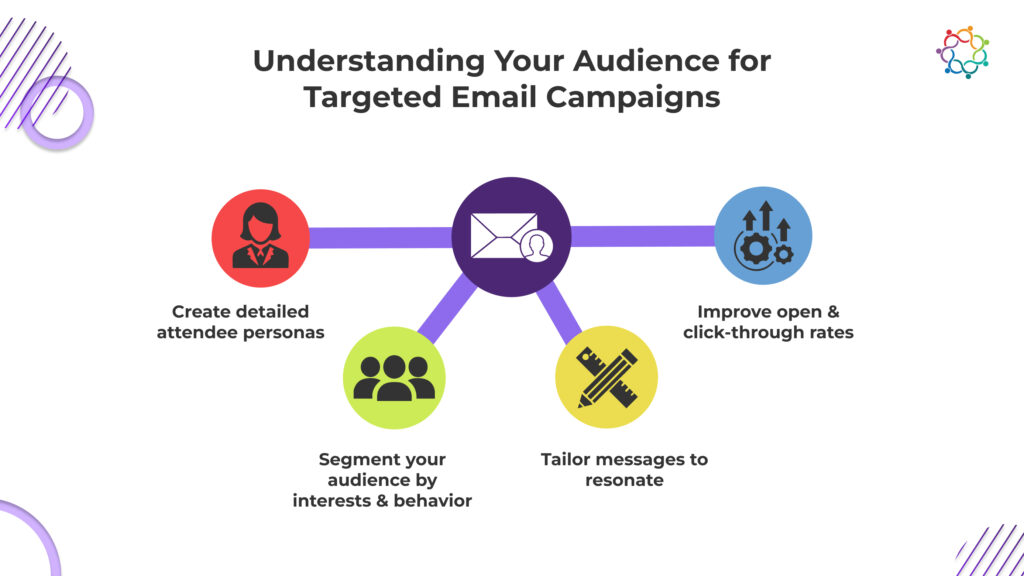
Before you write emails, you need to know exactly what the goals of your event are or what you want to achieve. Are you trying to raise registrations, increase actual attendance, increase engagement at the event, or have increased sales after the event? You will need to consider these goals when crafting all of your messages around the event.
In other words, when you know what your goals are, you can plan your campaigns that encourage attendees to take action towards those specific outcomes. That could be to click on a registration link, or to attend a session, or to share their feedback after the event.
Know Your Audience
The crux of email marketing will be the audience relevance; therefore, it is essential to conduct a deep dive into creating your attendee personas. Not just demographics – but real comprehension of their interests, challenges, reasons to attend, and their form of communication.
Once you have your personas, segment your lists and allow for segmentation into lists means that you will be sending the right message to the right audience groups, and increasing the odds that the audience will want to earnestly act on your message from the email.
As an example, perhaps new potential attendees need more education around the benefits of attending your event, while returning attendees might appreciate advance peeks or exclusives.
Crafting Emails that Matter
Now that you have established audience segments and goals, you will want to craft messages that clearly meet each group’s expectations and needs. Include language and a tone that is appropriate, and actions related to the event that matter to them.
Remember, “One size does not fit all.” You must personalize emails – and that means to segment the lists.
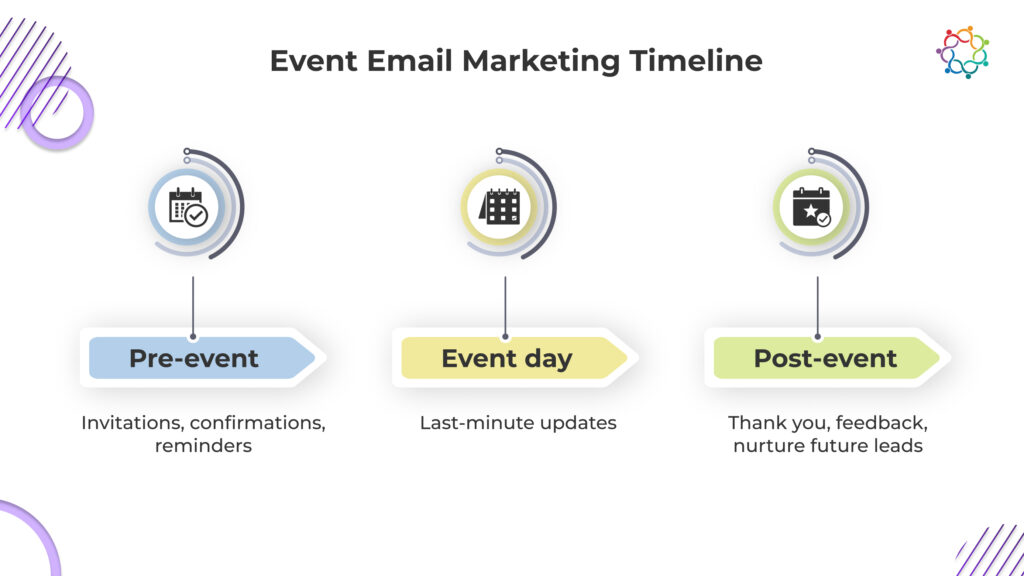
When considering event email marketing, it’s important to picture the journey from the time the first interest is sparked to long after the event has occurred. Planning this journey involves figuring out all the touchpoints you will have with your audience with email.
Start with all the communication leading up to the event, then keep all your registrants engaged until the event. Finally, map out all the follow-up email touches you will have post event.
Having a map or plan will help you make sure your emails will be sent on time, and the right message will be delivered.
Identifying the Email Types Needed for Your Event
Not all event emails are the same. There are event invitation emails, event registration confirmation emails, event reminder emails, event teaser emails, event follow up thank you and feedback emails.
Not all emails have the same purpose. They may invite, remind, engage or inform. By understanding the email types, you need to create, you will be stack up your content by each type of email needed.
Developing Your Event Email Marketing Timeline
When to send what email, is critical in event marketing. Create your timeline based around key event milestones – registration open date, early bird registration closes, speaker announcement, event day, etc.
For example, you send the initial invitation as soon as registration is opened, reminders leading up to the event, and you can also follow up with email right after the event ends.
Using an event timeline will keep your audience informed and engaged. This timely action prevents the frenzied rush near the end of registration that often causes people to forget to register.
Step 4: Creating core pre-event email campaigns that convert
The Magnetic Invitation Email
Your invitation email is your first point of contact. Make each email invite, your best. Be creative and hook your audience in your subject lines, while value-explaining why they should attend your event. Don’t forget to call attention to your key speakers, or how they will benefit from the event, or any unique sessions (say wine & canvas; or a kid’s act) that will make them not want to miss your event, as well as always including a CTA or what action you want them to take to make registration happen.
Flawless Registration Confirmation Emails
Now that someone has registered; now what. You want your confirmation email to set the tone of the event. Be sure to include all requried details: date, time, and location/access. Be sure to share an agenda (even a rough outline). Don’t forget to mention anything they should do next. You will also have an opportunity to hype up your event and reassure them as to why they made the right decision to attend your event!
Intelligent Reminder Emails
There are key milestones to afford yourself timing to remind them to attend your event; one week, one day, one hour. Anything after that is simply good value add to keep the event top of the mind. Reminders can also share last minute preparation info, like, what to bring along. Remember this is your last opportunity to market to your audience and your event may be days or weeks away so it would be to your advantage to also encourage a sense of urgency.
Teaser & Value-Add Emails
You have now sent some of your reminder emails but the trip to your event is not done. You want to keep your audience anticipating your event with some additional teasers. speakers, employers, and participants can demonstrate the value and impact of your event, creating additional excitement for attendees. For example, add personal touches that feature conference speakers or previous student testimonials (you can visit the event website or logged-in dashboard) demonstrating everything you’ve mentioned above.
Exploring Other Channels Beyond Email
Social media posts on Facebook (public groups), Twitter, and LinkedIn can generate buzz about your event, whether they refer to it as “the thing everyone’s talking about” or “the place to be.” Video previews, podcasts, and interviews with various speakers can also improve engagement on all events and help breathe life into advertisements related to your event (or venue) while reaching additional audiences and followers.
Using Event Apps for Growth
Some leaders in these markets still believe attendance is key to engagement with the information conveyed in your emails, presentations, or speaker sessions. However, we have also seen others valued event engagement apps over email and driven event attendance with remarkable success stories. Remember, start small with your app the first year and ask attendees for feedback. Before you know it, you will have maxed out the next app, and the stories will be endless about connecting, engaging, networking, and exchanging ideas that younger user groups quickly expect when attending your event or festival.
Using Event and Festival Marketing for Multiple Events
Send participants direct links to other events and even ask other event organizers if they can send a general email blast to attendees to promote your event. Use event blasts to blow the roof off at events. Event targeting is recent; it has given marketers personal style credibility with rotary and round-table style presentations. For example, hosting an annual event for the first time that receives a report on the outstanding marketing, targeting, and awareness raises the bar for organizers that want to come back that share/core’s values represent high expectations.
How are event apps advancing?
While apps like Eventbrite help host events and track simple metrics, apps like Whova, Gatherly, and Municipal are advancing intuitive event technology that engages participants. Event staff wish to advance their events by sharing focused educational messages while utilizing key tracking data to focus future programming and marketing approaches for future events. In-depth sharing from event apps will enhance leading content ideas in your pitches. For example, a keynote or speaker test from your last event to establish credibility with attendees if they see the event agenda outlined above during their registration process.
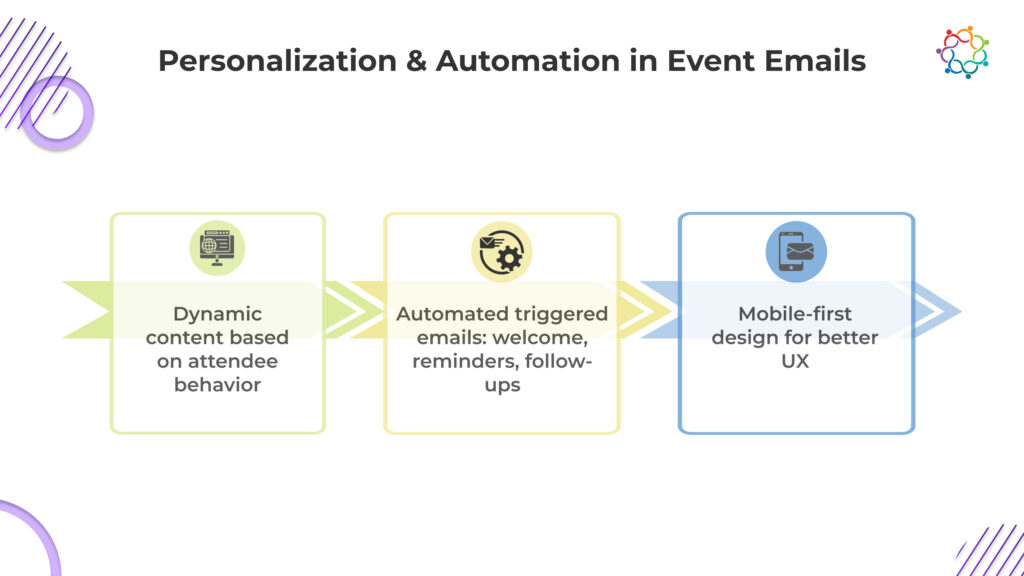
Hyper-Personalizing email communications can be much more than just adding the first name of the people receiving the email message. You can identify and utilize data on return (or not) attenders, interests, and behaviours to help you have more variable changing email content. Personal recommendations, personalized agendas or locations, can go a long way in boosting attendance, and showing your audience that you know what they want!
Automation
Automating your admissions e-mails enable you to save valuable time, but are also effective at communicating with your audience at the correct times as well. Set-up an automated trigger sequence to follow a registerable action, for example, welcome e-mail from when the person has registered, reminders leading up to the event, and post-event follow-ups. Automation enables organization of vital communications leading up to, during and after an event but can also keep your event where it needs to be on your audience members’ minds without manual effort.
Designing for Mobile-First & User Motivation
Since most emails are opened on mobile devices, it makes sense to design for mobile. Think about copy formatting (14 pt size), minimum wording is 25 words maximum for e-mail communications, larger buttons, and ensuring responsive layout for different devices. Always test your email on different mobile devices and computers to ensure it looks nice and works well. You want to provide the attendee with the best experience possible from the inbox to the event.
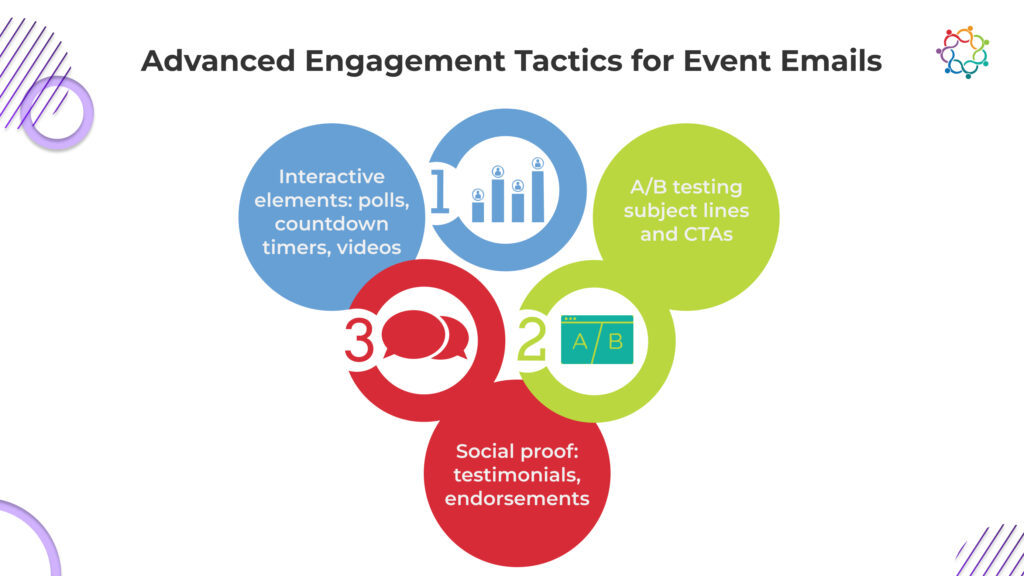
Adding any type of interaction creates attention and can encourage your emails to be memorable. An e-mail with a countdown timer can entice excitement by indicating the time they have to register (before the registration deadline), and a poll can provide quick feedback or preferences in moments.
Audiences love interacting and engaging in ways that pull them into the conversation within the e-mail provides even greater clicks, and potentially-interest from more attendees. Enjoying the A/B Testing for Continuous Improvement
Finding the right subject lines, calls to action (CTAs), images, and send times through testing allows you to identify what resonates with your audience. Frequently run A/B tests to enhance your messaging and design to increase open rates and conversions over time. Small changes can create a large impact on your campaign success.
Applying Social Proof & Testimonials
Social proof includes quotes from past attendees, statements of endorsement from speakers, and posts from social media. Each of these elements adds credibility – building trust through potential familiarity with positive experiences being conveyed from experiences of the past. Positive social proof also provides the event that human touch, making it feel both real and valuable.
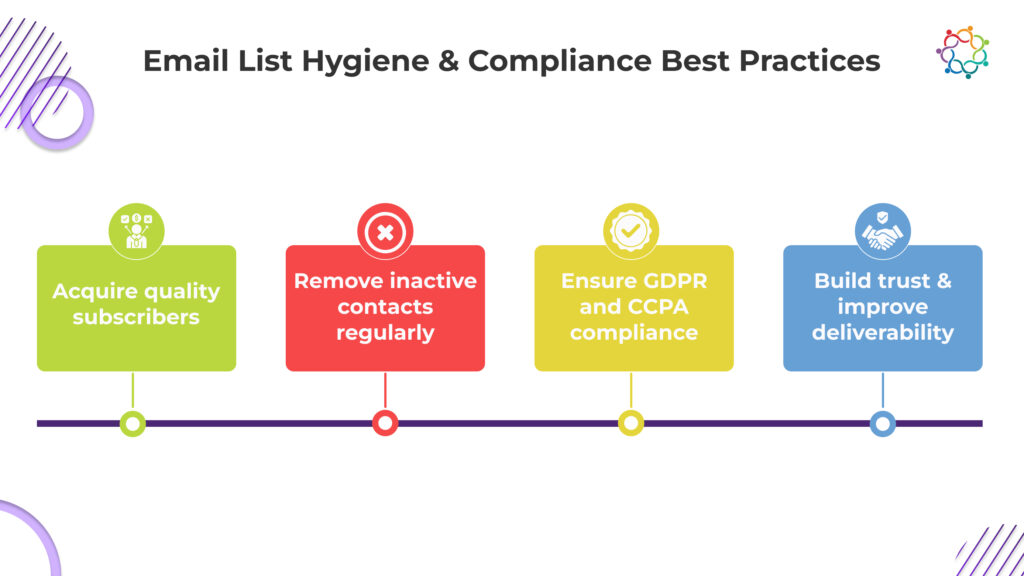
Be sure to keep your list clean, staying activated and compliant. To execute event email marketing with efficacy, it is pertinent to have an email list that is healthy. A healthy list will have your emails connected with the correct email addresses and not be assessed as spam ware, which will improve your campaign performance as a whole.
Best Practices for List Management:
If you want to engage your audience, then you should regularly remove any inactive, bad or bounced email addresses.
Segment your email lists based on the behaviours, demographics and engagement level of your audience to create targeted event promotion emails. Utilize re-engagement campaigns to reacquaint disengaged attendees before pruning.
Understanding Data Privacy and Compliance
Make sure that you are careful to fit your rights and obligations under laws such as GDPR and CCPA to build, and maintain trust, while also not exposing yourself to any potential liability.
Make your privacy policy clear and ensure that people can easily unsubscribe if they want to. Make sure you have good records of consent and constantly update your activities in scope with ever-evolving data protection laws.
Once you have a mastery of list hygiene and become compliant, you will be improving your deliverability, enhancing your credibility, and starting to position yourself for successful email marketing for events campaigns.
Step 8: Tracking Success: Key Metrics & Analytics for Optimization
Monitoring your key performance indicators (KPIs) is essential to establish a baseline and continue to improve your event email marketing activity. By thoroughly understanding your KPIs, you will be able to highly tune your performance and obtain maximum attendee engagement with your email marketing.
Essential KPIs for Event Email Marketing:
Analytics Tools:
Take advantage of your email marketing provider such as Mailchimp, HubSpot, etc. to create deeper reports.
Make sure to coordinate with your event registration/provider platform to help track not only your registration but tie it back to the email campaign which gives you event attendance.
This can help breakdown the data by event type, as well, and perhaps decisions you want to make moving forward such as differentiating between a webinar and a live event to see if an audience was more engaged during a certain type of event format.
Finding Patterns, Observing Trends, and Testing
Use your ongoing metrics to find patterns in your data, and then use this data to identify trends, alter subject lines, testing send times, and measuring follow-through so you can make improvements in your communications for registration, engagement and building a database of email addresses to follow-up post-event.
You will want to identify act-on behaviours amongst your identified trusts or groups.
To improve your campaign follow-up, consider segmenting your audience based on their behaviour and interests so you can send more effectively tailored and targeted emails.
To be continually iterative with your full campaigns and that every email you send contains relevant data is important.
Tracking its metrics ensures your email marketing for events is effective and therefore will adjust and improve as your audience has different needs.
Step 9: Post-Event Email Strategies to Leverage Your Engagement
Your email marketing for your event does not end after the event is over. While a good-to-do list item for you, your post-event communications are just as critical in helping nurture that relationship you have now fostered, gathering useful information on how you did, and laying the groundwork for the next event.
This email then reinforces the value that they received from your event and helps to create some goodwill and loyalty in your ongoing relationship.
Feedback and Surveys:
Remember that if you want and need to know where your attendees made or broke the experience, send them a targeted feedback form. You can also send them a survey or polls to gather information about your event, not only what they saw, but the experience they received and whether that knowledge transfer was actionable.
When you show you value what they say, you are drawing more of their engagement into the next time you communicate with them.
Nurturing leads and market future events:
Segment your attendees into categories based on their engagement and interests with your emails. Then you can send personalized follow-ups (which again adds to their engagement) with this targeted content and/or offers to their interests.
This also allows you to promote other upcoming $future$ events to expand your relationship and engagement beyond intimacy you built over the course of the event you just held.
By setting thinking post-event email campaigns after an event, you are actively looking to keep the life of your event to the extraordinary communication that you executed together with your audience.
Conclusion
Event tech is always evolving. As event professionals, we applaud the changes we see to help advance a young person’s engagement experience at events. No one said promoting and running an event would become easier!! Event tech and utilizing event apps to engage is the next promotional opportunity for event professionals to build on only think about attaining their history year on year. Increase your engagement by tracking your preferred events, firms, style, games, social impact, or if it is your venue’s warehouse to reward your event.
Explore our comprehensive guide for deeper strategies: Best Email Marketing Strategies for Event Promotion in 2025: Reaching Diverse Audiences.

Built for modern marketing teams, Samaaro’s AI-powered event-tech platform helps you run events more efficiently, reduce manual work, engage attendees, capture qualified leads and gain real-time visibility into your events’ performance.
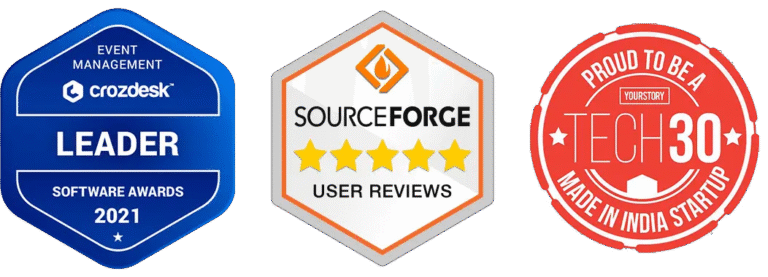
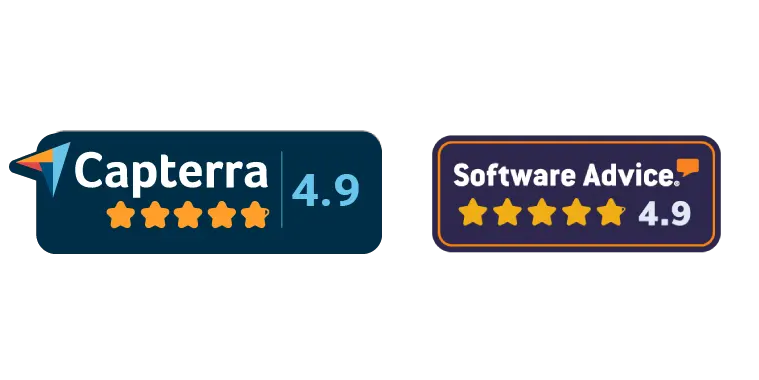
© 2025 — Samaaro. All Rights Reserved.